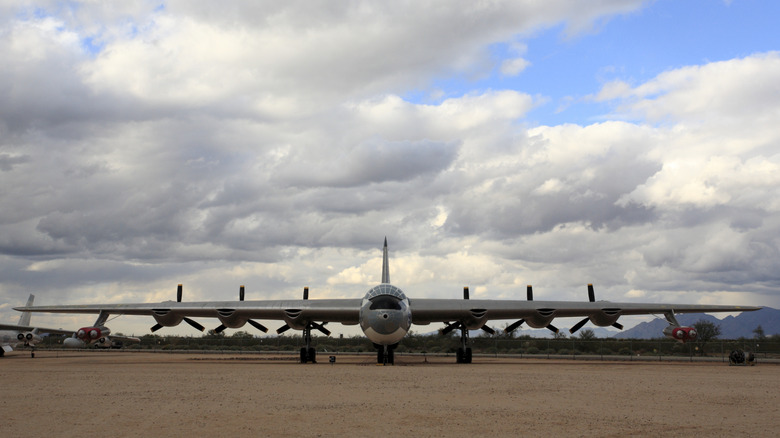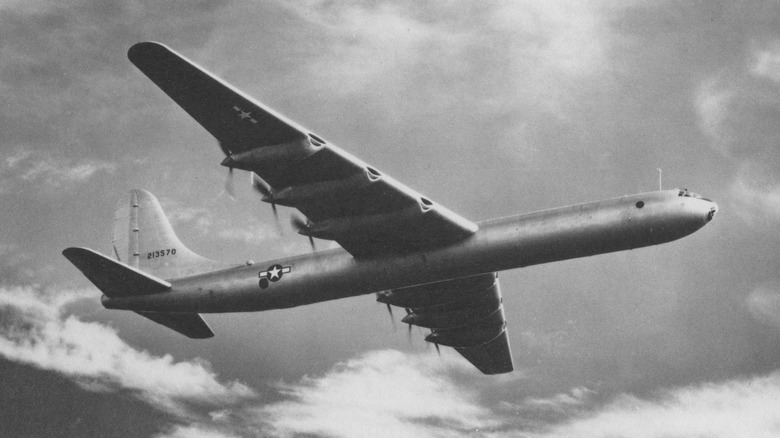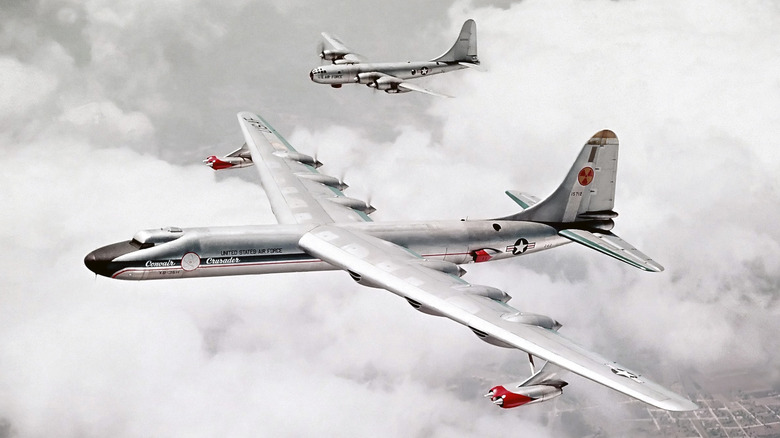Why The B-36 Peacemaker Is One Of The Worst Bombers Ever Made
When discussing historic bombers in American history, the B-36 Peacemaker ranks at the top in terms of size and design flaws. The B-36 was developed in 1941 during World War II and began its service in 1949, lasting only 10 short years before being retired in 1959. Built to fly from the U.S. to Europe without refueling, this long-range bomber was a gigantic aircraft with a 230-foot wingspan and six piston propeller engines that were prone to catching fire.
It took a crew of 15 to operate, and was criticized by both military and political leaders for being too expensive to maintain, costing billions, and too dangerous for the time period. An interesting fact is that the B-36 was actually considered too slow and outdated by the time it was ready for service. Its size and cost didn't translate to being effective, hence why many call it one of the worst bombers ever made.
Cold weather, engine fires, and too many spark plugs
Perhaps the biggest issue with the B-36 Peacemaker is one of its most standout features: the six Pratt & Whitney R‑4360 Wasp Major radial engines. These engines were set up in a push configuration, meaning they pulled air over the wings into the cylinders. This setup was flawed because it didn't allow for cooling, causing engines to overheat and catch on fire in mid-flight. Adding insult to injury were the insane number of sparkplugs on each of these Bombers, 336 to be exact, 56 per engine.
Because of the leaded high-octane fuel used, sparkplugs got fouled often, requiring frequent changes. The B-36 spent most of the time deployed in cold-weather regions like Alaska and the Arctic due to its close proximity to the Soviet Union, so it's easy to understand why crewmembers dreaded the task of changing sparkplugs in minus-degree temperatures. With a cruising speed of just 230 mph, it was considered slow and susceptible to being intercepted by more modern, faster jets like the Soviet MiG-15. Its cumbersome nature earned it the name "Flying dinosaur" and "aluminum overcast."
New plane, old concept
The design concept for the B-36 Peacemaker began in 1941, during a time when jet engine technology was still developing. By the time a prototype rolled around in 1946 and '48, more modern strategic jet bombers and interceptor technology were well underway. When the B-36 was finally operational, it was already obsolete.
Government leaders didn't bite their tongue about the B-36 bomber. It never dropped a bomb or flew any combat missions, and was dubbed the "billion-dollar blunder," leading to serious internal conflict; referred to as the Revolt of the Admirals amid post-war budget cuts in 1949. The U.S. Secretary of State wanted to cut Navy budgets in favor of the B-36, but Navy admirals weren't on board with the idea, calling it unreliable.
A nuclear test aircraft called Convair NB-36H was also built using a modified B-36, but beyond testing, the idea was also scrapped because of radiation shielding and contamination concerns. Without seeing any action, some will say the B-36 Peacemaker was a powerful deterrent against the Soviet Union during the Cold War, but it doesn't seem to help much with its poor legacy.


